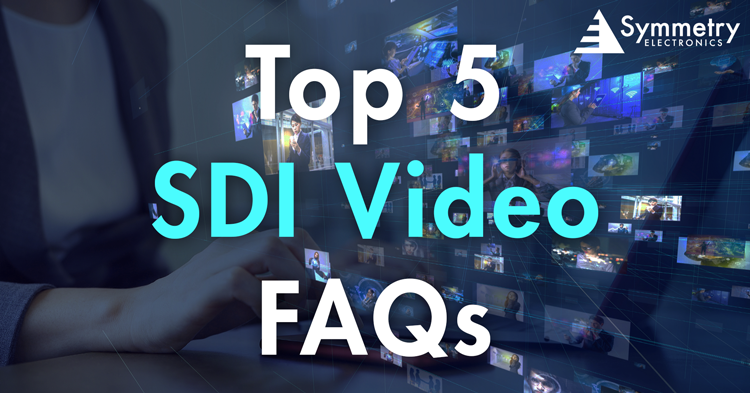- Home
- Symmetry Blog
- Top 5 SDI Video FAQs | Symmetry Blog
Top 5 SDI Video FAQs | Symmetry Blog
About Ray Pan
1. What is SDI?
Serial Digital Interface (SDI) is a family of interfaces standardized by the Society of Motion Picture and Television Engineers (SMPTE) for the transmission of uncompressed and unencrypted digital video signal with optional audio. The interface utilizes embedded synchronization packets to synchronize and ReClock video frames for transmitting and receiving. It can be single-link, dual-link or multi-link depending on the required data rate. The digital interface covers video signals from 270Mb/s standard definition (SD) up to today’s 12Gb/s ultra-high-definition (UHD) through coaxial cables over long distances. Depending on bit rate and cabling, distance varies from 100m to 300m–a standard that is widely used for interconnection between professional video equipment.
2. In system architecture, where does SDI fit in relation to the main processor?
SDI is the interface responsible for transmitting and receiving video signal through coaxial cables via a BNC connector in video application platforms.
Two typical design approaches for SDI include:
- FPGA + SDI: The FPGA and SDI architecture is most popular due to the flexible I/O and scalable characteristics of FPGAs. Several options are available to interconnect digital video signal between FPGA and SDI circuitry depending on the FPGA capability: SDI-to-SDI, differential pairs (e.g. low voltage differential signaling (LVDS)), and parallel bus.
- Application Processor (ASSP) + SDI: For ASSPs, LVDS and parallel buses are the most common physical links for routing digital video signals.
On the transmitting side, an SDI Serializer is responsible for serializing the digital video signal coming out of the main processor into the SDI standard. It is also responsible for driving the signal through the BNC connector via a Cable Driver for extended range.
On the receiving side, a Cable Equalizer is designed to equalize and restore the signal coming from the coaxial cable. It is required due to signal attenuation and cable loss through physical mediums. Additionally, an SDI De-Serializer deserializes the digital video signal to interface with an FPGA or ASSP.
Other SDI devices are used for improving signal integrity and system compatibility. A ReClock can remove clock jitter from cable noise. A Timing Generator offers low-jitter I/O frequency and synchronization among the video sources. A Gearbox facilitates interoperability between the SDI links or Crosspoint switches to enable video switching, distribution, and multi-view applications.
3. What are common applications for SDI?
SDI is mainly used in professional audio-video (pro AV) applications for point-to-point copper-based video applications:
- Cameras (security/medical/industrial)
- Camcorders (broadcasting)
- Video switch & distribution servers
- Presentation switchers
- Medical visualizations (endoscope, monitors)
- Digital signage
4. Why do customers choose SDI over HDMI?
HDMI transformed old analog AV into today’s full-bandwidth digital video format up to 6Gbps lane rate using 4 shielded twisted pairs as an HDMI cable. However, it can suffer from signal degradation at longer cable lengths, with performance being limited beyond 20 meters. Today’s video equipment is evolving towards 4K/8K video. As data rates increase, it becomes more challenging to transmit over longer distances.
SDI supports long distance applications without sacrificing signal integrity through widely used coaxial cables. A point-to-point connection requires less design effort for integration compared to video-over-IP connections that have complex infrastructure requirements.
The High-bandwidth Digital Content Protection (HDCP) encryption enforced by HDMI presents another challenge for end users in the industrial or medical segments, where content is either proprietary or not copyright protected. Additionally, there is an associated annual fee to utilize an HDCP license adaptor for HDCP-enabled HDMI devices–thus increasing the overall system cost.
Comparing the connectors used in each standard, SDI uses the long-established BNC connector, known for its secure cable lock-in mechanism, durability and field repairability. Conversely, HDMI connectors lack a secure lock mechanism, are complex to assemble, and cannot be field repaired.
HDMI has been widely adopted in today’s video devices to provide for compatibility between different video systems. However, SDI is still seen as a better solution for mission critical environments or applications. The use case should be well considered before choosing your interface for video transmitting/receiving.
5. Why do customers upgrade SDI?
- Requirement for higher bit-rate to support higher resolution video format: 270Mbps (SD), 1.48Gbps (HD-720P), 2.97Gbps (HD-1080P@60Hz), 6Gbps (4K@30Hz), 12Gbps (4K@60Hz) and soon 24G (8K@30Hz)
- Single-Link to Dual-Link/Multi-link conversion, or vice-versa
- Conversion between SDI and newer video interfaces
- Performance issue with clock jitter and signal degradation
- Compatibility issues among SDI standards

